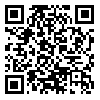Download citation:
BibTeX | RIS | EndNote | Medlars | ProCite | Reference Manager | RefWorks
Send citation to:



BibTeX | RIS | EndNote | Medlars | ProCite | Reference Manager | RefWorks
Send citation to:
Shakeri Goki M H, Atoof F, Norouzi A, Ezzedin al-Khatib N, Mirhosseini F. Self-regulation of Motivation and Its Relationship with Demographic Variables in Undergraduate Anesthesia Students. Iranian Journal of Medical Education 2023; 23 :323-332
URL: http://ijme.mui.ac.ir/article-1-5700-en.html
URL: http://ijme.mui.ac.ir/article-1-5700-en.html
Mohammad Hossein Shakeri Goki 

 , Fateme Atoof
, Fateme Atoof 

 , Ali Norouzi
, Ali Norouzi 

 , Nazdar Ezzedin al-Khatib
, Nazdar Ezzedin al-Khatib 

 , Fakhrosadat Mirhosseini *
, Fakhrosadat Mirhosseini * 




 , Fateme Atoof
, Fateme Atoof 

 , Ali Norouzi
, Ali Norouzi 

 , Nazdar Ezzedin al-Khatib
, Nazdar Ezzedin al-Khatib 

 , Fakhrosadat Mirhosseini *
, Fakhrosadat Mirhosseini * 


Department of Medical Education, School of Allied Medical Sciences Anesthesia Department Kashan University of Medical sciences, Kashan, Iran. & Medical Sciences Education Association of the Islamic Republic of Iran. , f_mirhoseiny@yahoo.com
Abstract: (766 Views)
Introduction: During education, self-regulation strategies of motivation maintain and improve motivation. Undergraduate anesthesia students employ motivation regulation strategies due to their challenging academic conditions. This study endeavors to determine the extent undergraduate anesthesia students use motivation regulation strategies as well as the relationship between these strategies with age, gender, marital status, academic year and number of completed online semesters.
Methods: This cross-sectional descriptive study was conducted among 358 students in the 2022 academic year. Convenient sampling was used and data gathered using Norouzi et al.'s (2020) questionnaire. As to descriptive analysis of data and the relationship of strategies with demographic variables, Mann-Whitney U test, Kruskal–Wallis H test and Spearman's correlation coefficient were used. The correlation between strategies was measured with Spearman's correlation coefficient, the mean score of the subscales was standardized, and the difference between the means was shown by analysis of variance with repeated measurements.
Results: The results revealed that Spearman's correlation coefficient between all subscales was above 0.3. Gender, number of online semesters with regulation of situational interest strategy, and marital status variables with preventive situational awareness strategy and relational strategy, respectively (p<0.05) were related. However, the age variable had an inverse correlation with the environmental organization and situational interest regulation subscales (p<0.05), the standardized score of undergraduate anesthesia students in most of the subscales were significantly different p< .001.
Conclusion: The results of this study suggested that undergraduate anesthesia students do not use motivational regulation strategies to the same extent. Besides, some motivational regulation strategies are related to demographic variables.
Type of Study: Original research article |
Subject:
Curriculum Development
Received: 2023/10/13 | Accepted: 2024/02/3 | Published: 2023/03/30 | ePublished: 2023/03/30
Received: 2023/10/13 | Accepted: 2024/02/3 | Published: 2023/03/30 | ePublished: 2023/03/30
Send email to the article author
| Rights and permissions | |
 |
This work is licensed under a Creative Commons Attribution-NonCommercial 4.0 International License. |



